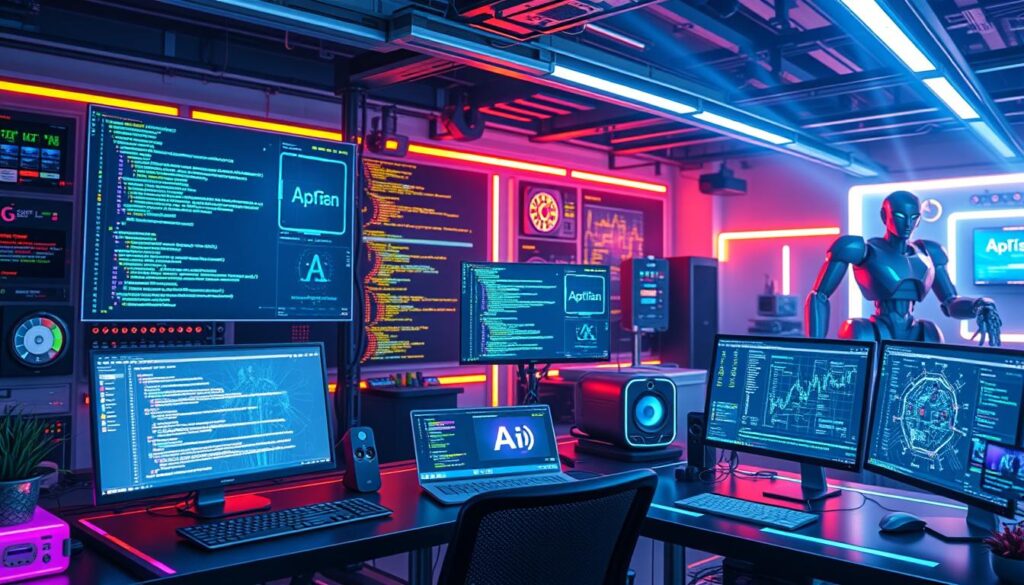Software development is changing fast because of cutting-edge technologies. These technologies change what’s possible and make things more efficient. Fively is leading this change by using the latest software technologies. They create complex solutions for many sectors. With machine learning, artificial intelligence, and cloud computing, industries are transforming. Businesses like Fively use these changes to improve software development. This leads to better operations and results.
Gartner’s 2023 forecast shows a big jump in low-code development, expecting a 20% growth. Developers are using these advanced software development tools more. They make sure their applications are cutting-edge and effective. For example, artificial intelligence is changing healthcare in patient care and admin tasks. Also, cloud solutions give easy access to powerful computing resources. This makes technology more available to everyone.
Industries are moving towards faster and smoother app deployment. DevOps and Continuous Integration are key to making this happen. Also, the need for agile and compatible software is pushing mobile development forward. Looking into 2024, NLP, AI, Blockchain, and Microservices will be necessary. They are important for developers who want to keep leading in software innovation.
Key Takeaways
- It’s important for businesses to keep up with software innovation. This helps them stay competitive.
- Using the latest software technologies like AI, cloud computing, and microservices improves efficiency and customer happiness.
- Low-code/no-code platforms will change how apps are developed. They offer speed and easy access.
- The advanced software development field now depends more on continuous integration and DevOps. This is for quicker deployment and better growth.
- New technologies bring challenges, like security issues and the risk of becoming outdated quickly. This needs careful and flexible strategies.
Introduction to Cutting-Edge Technologies
Emerging software technologies are changing industries by creating new standards in development. These changes aren’t just trends. They are key shifts in how companies work and bring products to the market. Focusing on better performance and user involvement, these technologies point to a future of automation and accuracy.
Definition and Importance
Cutting-edge technologies mean the newest and best software advancements out there. They’re important because they offer new solutions to tough problems, making things run smoother and more efficiently in many areas. By adopting these technologies, companies stay competitive and encourage innovation.
Not only do they boost productivity, but these technologies also make the software better and more dependable. They get applications to users faster. And they cut costs by using resources wisely and reducing waste in making software.
Current Trends in Software Development
The software development scene is always changing, thanks to new technologies and what the market wants. Here are the latest trends:
- Cloud computing advancements, like pay-as-you-go models, lower costs.
- More use of microservices architecture makes applications stronger and more flexible.
- AI and machine learning help use data better, improving decisions and making experiences more personal.
- With low-code and no-code platforms, making software is quicker and opens the door for more creators.
- There’s a big demand for better cybersecurity to protect digital stuff and personal data.
These technologies are crucial for businesses wanting to make the most of software advancements. They help solve problems creatively and make groundbreaking products.
| Technology | Impact on Software Development | Example Companies |
|---|---|---|
| AI & ML | Boosts automation, makes data handling better and more accurate. | Google, IBM |
| Cloud Computing | Lowers costs, makes remote working on projects easier. | Microsoft, Amazon |
| Quantum Computing | Allows for quicker, more complex calculations. | IBM, Google |
| Blockchain | Improves the security of transactions and data storage. | Various startups |
| Robotic Process Automation | Cuts down on manual work, reduces costs. | UiPath, Automation Anywhere |
Using and blending in these top software solutions not only brings advanced capabilities but also prepares the ground for future software inventions.
Artificial Intelligence in Software Development
The realms of software development are ever-changing, thanks to AI, machine learning (ML), and natural language processing (NLP). These technologies are not just bettering how we develop software. They are also expanding the boundaries of what software can achieve. Exploring machine learning and NLP shows how AI is creating new standards in software.
Machine Learning Applications
ML is key in stretching software capabilities. By studying past data, ML algorithms can make accurate predictions. This allows for the creation of smarter and more responsive software. For example, tools like GitHub Copilot and Tabnine give code suggestions. They boost how well and quickly developers write code.
Also, AI automates the testing and quality checking processes. This lessens the need for error-prone manual tests. Tools like Mabl and Applitools mimic user actions on various platforms. They ensure software works well on different devices. AI’s predictive power also helps manage resources better and prevent system breakdowns ahead of time.
Natural Language Processing Enhancements
NLP has changed how software understands human language, making it more intuitive. It lets applications understand texts and speech like humans do. For instance, Google Cloud Natural Language helps developers add complex language understanding to their apps. This makes it easier for apps to grasp user commands.
NLP is vital in automating customer services, like chatbots and feedback analysis. These AI systems not only respond to questions but also learn from them. This makes user experiences more customized. NLP is narrowing the communication gap between humans and machines, allowing for more creative software interactions.
In summary, integrating AI, ML, and NLP into software development pushes technology forward and gives developers a competitive edge. This blend of AI technologies is essential for creating smart, flexible software solutions.
Cloud Computing Advances
Software development is changing fast thanks to cloud computing. This important change is backed by modern software tools and strong cloud architecture. This makes it possible for organizations to use cloud-native apps. They gain in speed and agility, improving their work and new ideas.
Optimize IT operations with AI and cloud solutions combine new tech with the needs of today. This keeps businesses ahead in a fast-moving digital world.
Benefits of Cloud-Native Applications
Cloud-native apps offer firms a way to be more resilient and flexible. They can scale up easily and blend with other services. Moving to cloud architecture means faster updates and better data handling. This leads to smarter decisions.
Serverless Architecture Explained
Serverless computing is a big leap in tech, taking away server upkeep tasks from developers. This lets them focus more on writing code. This makes launching apps quicker and cheaper. It uses a pay-as-you-go model, matching financial sense with project growth.
| Feature | Cloud-Native | Serverless |
|---|---|---|
| Deployment Speed | Rapid | Immediate |
| Cost Efficiency | High | Optimized |
| Scalability | Dynamic | Automatic |
| Management | Simplified | Minimal |
| Security | Enhanced | Integrated |
As modern software tools, cloud architecture, and serverless computing come together, we see unlimited potential. Moving to these advanced systems helps tech growth. It also boosts the economy and makes businesses agile.
Mobile Development Innovations
Mobile app development has changed a lot, helping businesses and people interact with technology better. Tools for rapid application development make creating powerful, feature-filled apps quicker. The introduction of 5G, IoT, and AI in mobile apps gives developers new powers for instant communication and better user interaction.
Frameworks for Rapid Development
Frameworks like Flutter, React Native, and Xamarin are key for developers who want to work fast and efficiently. These tools let developers write one codebase for multiple platforms, like iOS and Android. This approach saves time and reduces costs. Tools like Flutter also help create mobile and web apps from the same code, making the app experience seamless.
Cross-Platform Solutions
Cross-platform development makes mobile apps work on different devices, improving how users access them. Progressive Web Apps (PWAs) mix web and mobile app features to give fast and smooth experiences on any device. This flexibility is vital for businesses trying to reach more people without spending a lot on different app versions.

Adding IoT to mobile app development brings more automation and connection. IoT-enabled apps connect with devices, giving businesses instant data to make better decisions and work more efficiently. With devices linking up more, mobile apps become central in controlling them, opening new chances for innovation.
For more details on how these tech upgrades can help your business, check out custom software development solutions. They can give personalized advice on using these new development ways to improve your products and engage users more.
| Technology | Impact on Mobile App Development |
|---|---|
| 5G Integration | Makes data transfer faster, improving instant communication and media-rich experiences for users. |
| AI and ML Integration | Boosts app smarts and flexibility, offering customized experiences and predictive features for users. |
| Blockchain | Enhances security and data accuracy, making mobile transactions more trustworthy and reliable. |
DevOps and Continuous Delivery
DevOps and continuous delivery are changing software development fast. They make the development cycles quicker and more efficient. By using DevOps advancements, companies boost productivity and lead in deployment automation and continuous integration.
Automation Tools Transforming DevOps
Tools like Jenkins, Chef, and Ansible are key for DevOps. Jenkins improves continuous integration by letting developers add changes often and find errors early. Chef and Puppet handle server setups automatically, making things consistent and simpler. This helps speed up development and meets DevOps goals of better operational efficiency.
Benefits of Continuous Integration
Continuous integration is vital in DevOps. It lets teams merge changes many times a day.
This lowers risks and boosts software quality. It also cuts the time to market, making project management more agile. Continuous delivery adds to those gains by automating releases, making dependable, frequent deployments possible.
Diverse sectors like tech, finance, and healthcare find DevOps and continuous integration crucial. They offer flexibility and scalability, essential for thriving in today’s digital market.
Grasping continuous integration and deployment automation in DevOps can transform your company’s culture. It encourages innovation and faster delivery, maintaining high product quality.
Blockchain Technology in Software Development
Blockchain technology is becoming key in making software more secure, efficient, and trustworthy. It brings better data security and new methods, like smart contracts. These contracts make business processes smoother.
Use Cases Beyond Cryptocurrency
Blockchain isn’t just for cryptocurrency. It’s changing how we handle data in healthcare, finance, and logistics. By using blockchain, these industries are fighting fraud, making transactions faster and more secure, and keeping data accurate. For example, its unchangeable ledger is crucial for tracking goods in supply chains. Moreover, real estate benefits from safer and more efficient title transfers, cutting down fraud risks.
Smart Contracts and Their Impact
Smart contracts are changing how businesses work by automating agreements. This cuts costs and speeds up transactions. They’re especially useful in insurance, quickly activating claims when certain conditions are met. This reduces delays and disputes. These contracts follow set rules strictly, making sure everyone sticks to the terms.
Here’s a table showing how blockchain-based smart contracts improve over traditional methods:
| Aspect | Traditional Processes | Blockchain Solutions |
|---|---|---|
| Data Security | Prone to breaches and fraud | Enhanced with encryption, immutability |
| Efficiency | Time-consuming, error-prone | Highly efficient via automation |
| Cost | Higher due to intermediaries | Lowered by eliminating middlemen |
| Transparency | Often opaque | Fully transparent and verifiable |

Blockchain in software development is set to grow more. Innovations are being made to tackle challenges like scalability and regulatory rules. As various industries see blockchain’s benefits for secure and streamlined operations, its use in mainstream software will only grow. We’re stepping into a new era of digital transactions.
The Role of Microservices Architecture
Software architecture has evolved. Firms have shifted from monolithic to microservices structures. This change boosts business efficiency and tech flexibility. Microservices offer agility and meet business goals. They are used by big companies like Netflix and Amazon. It’s key to understand the benefits and challenges of microservices in software development today.
Advantages Over Monolithic Designs
When comparing monolithic and microservices, microservices shine in scalability and flexibility. Netflix moved from a DVD rental to handling complex online interactions thanks to microservices. The advantages include:
- Scalability: Each part can grow separately. This improves performance and cost savings when demand changes.
- Flexibility: Teams can use different technologies for each service they work on.
- Resilience: If one part fails, it doesn’t bring down everything.
- Speed of Deployment: Updating is quicker with smaller services, giving businesses a competitive advantage.
These features match the need for agility and business growth, fueling ongoing innovation in today’s digital world.
Challenges of Microservices Implementation
Microservices come with challenges despite their benefits. Companies must handle:
- Increased Complexity: More services mean more complexity in deploying, testing, and managing operations.
- Consistent Data Management: Each service has its own data. Strategies to keep data consistent across the system are crucial.
- Inter-service Communication: Strong communication between services is essential to avoid data loss and maintain availability.
Moving to microservices from a monolithic approach requires big changes in company culture and tech setups. Typically, this demands planned, phased approaches.
| Parameter | Monolithic Architecture | Microservices Architecture |
|---|---|---|
| Scalability | Limited to application-wide scaling | Specific to components, highly adaptable |
| Flexibility in Tech | One technology stack | Diverse tech across different services |
| Deployment Speed | Slower, due to bigger app size | Quicker, thanks to updates in independent services |
| Fault Isolation | Affects the whole system | Restricted to the affected service, improving reliability |
Despite these challenges, companies like Amazon and Netflix have successfully embraced microservices. They’ve added new features like canary releases and circuit breakers to gradually improve their platforms. This ongoing development highlights the adaptable and resilient nature of microservices architecture, setting a standard for future tech deployments.
Future Trends in Software Development
The future of software development is moving away from simple, single-unit programs. Now, we’re heading towards complex systems like microservices. This change is due to the need for scalability and easier maintenance. Languages that focus on high performance are playing a key role now. This shift points to new tech that will change how we create software.
Predictions for the Next Decade
The next ten years in development look quite thrilling. We’ll see AI-driven software tools, full DevSecOps practices, and easy-to-use platforms. These advances will make creating apps faster and improve how users interact with them. AI will also help secure apps while they’re being made. Plus, quantum computing will bring even stronger security measures. This all means computing power like never before.
Emerging Technologies to Watch
There’s excitement over making computing more energy-efficient. Developers are turning to algorithms inspired by quantum theory to make greener digital products. By 2025, we expect big things in agile frameworks that are easy on the environment. Voice recognition in mobile apps will get smarter, understanding emotions and different cultures better. This journey towards efficient and secure software is just beginning. We’re aiming for software that works perfectly everywhere, on any device.



